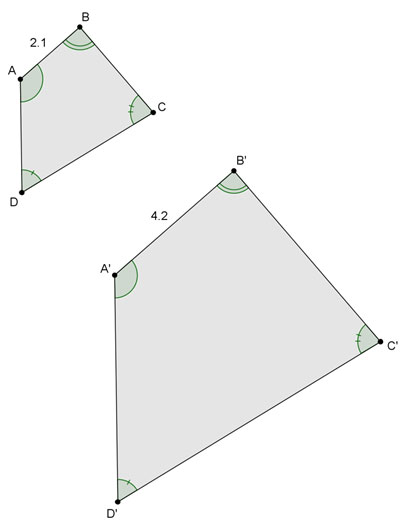In this section, you will extend what you have seen so far with side lengths and areas of similar triangles to similar rectangles. In particular, you will examine patterns in perimeters and areas of similar rectangles.
![]() Click on the image below to open the activity. Click on the orange points to adjust the dimensions of Rectangle A and the scale factor (using the slider). Click the Graphs button to see graphs of the relationships, and click the Measures button to see the measures and ratios with length, perimeter, and area of the two similar rectangles. Use the interactive and your explorations within the interactive to complete the table beneath the image.
Click on the image below to open the activity. Click on the orange points to adjust the dimensions of Rectangle A and the scale factor (using the slider). Click the Graphs button to see graphs of the relationships, and click the Measures button to see the measures and ratios with length, perimeter, and area of the two similar rectangles. Use the interactive and your explorations within the interactive to complete the table beneath the image.
Copy and complete the table comparing the ratios of the lengths of the given sides of the rectangles above in your notes.
| Length of Rectangle A | Width of Rectangle A | Scale Factor | L' over L L' L = W' over W W' W | Perimeter of A over Perimeter of B Perimeter of A Perimeter of B | Perimeter of A over Perimeter of B Area of A Area of B |
| 194 | 120 | 1.50 | |||
| 168 | 67 | 1.50 | |||
| 150 | 80 | 2.00 | |||
| 85 | 100 | 2.00 |
Interactive popup. Assistance may be required.
| Length of Rectangle A | Width of Rectangle A | Scale Factor | L' over L L' L = W' over W W' W | Perimeter of A over Perimeter of B Perimeter of A Perimeter of B | Perimeter of A over Perimeter of B Area of A Area of B |
194 |
120 |
1.50 |
1.50 |
1.50 |
2.25 |
168 |
67 |
1.50 |
1.50 |
1.50 |
2.25 |
150 |
80 |
2.00 |
2.00 |
2.00 |
4.00 |
85 |
100 |
2.00 |
2.00 |
2.00 |
4.00 |

Interactive popup. Assistance may be required.
The scale factor is equal to the ratio of the lengths of corresponding sides.
Interactive popup. Assistance may be required.
The scale factor is equal to the ratio of the perimeters.
Interactive popup. Assistance may be required.
The ratio of the areas is equal to the square of the scale factor.
Interactive popup. Assistance may be required.
The ratio of the areas is equal to the square of the ratios of the lengths of corresponding sides.
Interactive popup. Assistance may be required.
The relationship could be modeled by a quadratic function because area is a two-dimensional measure.
Interactive popup. Assistance may be required.
The relationship could be modeled by a quadratic function because area is a quadratic, or square, measure.
If the scale factor is between 0 and 1, the dilation of the original rectangle would be a reduction instead of an enlargement. Do you think the same patterns between scale factor and ratio of perimeters and scale factor and ratio of areas would hold true? Use the interactive sketch to confirm your prediction.
Use the two similar quadrilaterals shown in the figure below to answer questions 1-3.

Interactive popup. Assistance may be required.
What is the ratio between the lengths of the two labeled corresponding sides?
Interactive popup. Assistance may be required.
B'C' = 7 centimeters
Interactive popup. Assistance may be required.
How does the ratio of the perimeters of similar figures compare to the ratio of the lengths of corresponding sides?
Interactive popup. Assistance may be required.
The ratio of the perimeters is equal to the ratio of the lengths of the corresponding sides, which is equal to 2.
Interactive popup. Assistance may be required.
How does the ratio of the perimeters of similar figures compare to the ratio of the lengths of corresponding sides?
Interactive popup. Assistance may be required.
The ratio of the areas is equal to the square of the ratio of the lengths of the corresponding sides. The ratio of the areas is equal to 4.